Potential Reduction in Carbon Emissions in the Transport of Aggregates by Switching from Road-Only Transport to an Intermodal Rail/Road System
Abstract
1. Introduction
2. Methodology
2.1. Literature Review
2.2. Data Sources and Preparation
2.2.1. Location of the Quarries
2.2.2. Road Network
2.2.3. Rail Network
2.2.4. Production and Demand Values
2.3. Methods of Analysis
2.3.1. Road Distance Estimation Methodology
2.3.2. Combined Train/Road Distance Estimation Methodology
- Only one intermodal terminal is defined for each of the four railway lines suitable for freight transport approaching Madrid: four intermodal terminals were defined.
- The intermodal terminals must be adjacent to the railway lines.
- Intermodal terminals must be located within industrial areas.
2.3.3. Emissions and Costs Calculation Methodology for Different Productions
3. Results
3.1. Quarries in Madrid and Surrounding Provinces
3.2. Railway and Road Network for Freight Transport
3.3. Aggregate Production and Demand
3.4. Total Distance Traveled and Carbon Emissions
4. Discussion
4.1. Key Findings
4.2. Comparison of the Findings with the Literature
4.3. Strengths and Limitations
4.4. Policy Implications
5. Conclusions
Author Contributions
Funding
Institutional Review Board Statement
Informed Consent Statement
Data Availability Statement
Acknowledgments
Conflicts of Interest
References
- Eun Oh, J.; Espinet Alegre, X.; Pant, R.; Koks, E.E.; Russell, T.; Schoenmakers, R.; Hall, J.W. Addressing Climate Change in Transport. Volume 2: Pathway to Resilient Transport; The World Bank: Singapore, 2016; p. 154. [Google Scholar]
- Eurostat. Net Greenhouse Gas Emissions. Available online: https://ec.europa.eu/eurostat/databrowser/view/SDG_13_10/default/table?lang=en (accessed on 15 September 2023).
- Wiegmans, B.; Champagne-Gelinas, A.; Duchesne, S.; Slack, B.; Witte, P. Rail and road freight transport network efficiency of Canada, member states of the EU, and the USA. Res. Transp. Bus. Manag. 2018, 28, 54–65. [Google Scholar] [CrossRef]
- Gialos, A.; Zeimpekis, V.; Madas, M.; Papageorgiou, K. Calculation and Assessment of CO2e Emissions in Road Freight Transportation: A Greek Case Study. Sustainability 2022, 14, 10724. [Google Scholar] [CrossRef]
- Jiang, R.; Wu, P.; Wu, C. Driving Factors behind Energy-Related Carbon Emissions in the U.S. Road Transport Sector: A Decomposition Analysis. Int. J. Environ. Res. Public Health 2022, 19, 2321. [Google Scholar] [CrossRef] [PubMed]
- Mendoza-Sanchez, J.F.; Alonso-Guzman, E.M.; Martinez-Molina, W.; Chavez-Garcia, H.L.; Soto-Espitia, R.; Obregón-Biosca, S.A.; Delgado-Alamilla, H. Measurement of CO2 Emissions by the Operation of Freight Transport in Mexican Road Corridors. Appl. Sci. 2023, 13, 11391. [Google Scholar] [CrossRef]
- IEA. Transport, Energy and CO2, Moving Toward Sustainability; International Energy Agency Report: Paris, France, 2009; p. 418. [Google Scholar]
- Milewski, D.; Milewska, B. Efficiency of the Consumption of Energy in the Road Transport of Goods in the Context of the Energy Crisis. Energies 2023, 16, 1257. [Google Scholar] [CrossRef]
- Heinold, A.; Meisel, F. Emission rates of intermodal rail/road and road-only transportation in Europe: A comprehensive simulation study. Transp. Res. Part D Transp. Environ. 2018, 65, 421–437. [Google Scholar] [CrossRef]
- European Commission. Transport White Paper—Roadmap to a Single European Transport Area—Towards a Competitive and Resource Efficient Transport System. Available online: https://eur-lex.europa.eu/LexUriServ/LexUriServ.do?uri=COM:2011:0144:FIN:en:PDF (accessed on 4 January 2024).
- Boldizsár, A.; Mészáros, F.; Sipos, T. Spatiality in freight transport efficiency. Acta Oeconomica 2023, 73, 327–345. [Google Scholar] [CrossRef]
- Sun, Y.; Sun, G.; Huang, B.; Ge, J. Modeling a Carbon-Efficient Road–Rail Intermodal Routing Problem with Soft Time Windows in a Time-Dependent and Fuzzy Environment by Chance-Constrained Programming. Systems 2023, 11, 403. [Google Scholar] [CrossRef]
- Kine, H.Z.; Gebresenbet, G.; Tavasszy, L.; Ljungberg, D. Digitalization and Automation in Intermodal Freight Transport and Their Potential Application for Low-Income Countries. Future Transp. 2022, 2, 41–54. [Google Scholar] [CrossRef]
- Escavy, J.I.; Herrero, M.J.; Trigos, L.; Sanz-Pérez, E. Demographic vs economic variables in the modelling and forecasting of the demand of aggregates: The case of the Spanish market (1995–2016). Resour. Policy 2020, 65, 101537. [Google Scholar] [CrossRef]
- UNEP GEAS. Sand, Rarer than One Thinks; UNEP GEAS: Sioux Falls, SD, USA, 2014; Volume 15. [Google Scholar]
- López-Acevedo, F.J.; Escavy, J.I.; Herrero, M.J. Application of Spatial Data Mining to national mines inventories for exploration and land planning of high place-value mineral resources. The case of aggregates in Spain. Resour. Policy 2022, 79, 103096. [Google Scholar] [CrossRef]
- López-Acevedo, F.J.; Herrero, M.J.; Escavy, J.I.; Peláez Fernández, M.A. Identification of Aggregates Quarries via Computer Vision Analysis as a Tool for Sustainable Aggregates Management and Land Planning. Sustainability 2024, 16, 3099. [Google Scholar] [CrossRef]
- UEPG. Aggregates Europe—UEPG Annual Review 2019–2020; UEPG: Ponta Grossa, Brazil, 2020. [Google Scholar]
- Aquino, C.; Inoue, M.; Miura, H.; Mizuta, M.; Okamoto, T. The effects of limestone aggregate on concrete properties. Constr. Build. Mater. 2010, 24, 2363–2368. [Google Scholar] [CrossRef]
- Yılmaz, M.; Tuğrul, A. The effects of different sandstone aggregates on concrete strength. Constr. Build. Mater. 2012, 35, 294–303. [Google Scholar] [CrossRef]
- Escavy, J.; Herrero, M. The use of location–allocation techniques for exploration targeting of high place-value industrial minerals: A market-based prospectivity study of the Spanish gypsum resources. Ore Geol. Rev. 2013, 53, 504–516. [Google Scholar] [CrossRef]
- Global Market Insights Inc. Construction Aggregates Market Size—By Product (Sand, Gravel, Crushed Stone), by Application (Residential, Commercial, Nonbuilding Construction). Industry Analysis Report & Global Forecast, 2023–2032. Available online: https://www.gminsights.com/industry-analysis/construction-aggregates-market (accessed on 26 September 2023).
- ANEFA. Revista Anual 2019–2020; ANEFA: Mont de Marsan, France, 2020; Volume 84. [Google Scholar]
- Escavy, J.I.; Herrero, M.J.; Lopez-Acevedo, F.; Trigos, L. The progressive distancing of aggregate quarries from the demand areas: Magnitude, causes, and impact on CO2 emissions in Madrid Region (1995–2018). Resour. Policy 2022, 75, 102506. [Google Scholar] [CrossRef]
- Van der Meulen, S.; Grijspaardt, T.; Mars, W.; Van der Geest, W.; Roest-Crollius, A.; Kiel, J. Cost Figures for Freight Transport—Final Report; Panteia: Zoetermeer, The Netherlands, 2023; p. 86. [Google Scholar]
- Gandhi, N.; Kant, R.; Thakkar, J.J. Evaluation of benefits due to adoption of enablers of unimodal road to intermodal railroad freight transportation. Transp. Policy 2024, 146, 295–311. [Google Scholar] [CrossRef]
- Agioutantis, Z.; Komnitsas, K.; Athousaki, A. Aggregate transport and utilization: Ecological footprint and environmental impacts. Bull. Geol. Soc. Greece 2013, 47, 1960–1969. [Google Scholar] [CrossRef]
- Almagro, A.; Almagro-Gorgea, M. El Anfiteatro en la Hispania Romana. Coloquio Internacional; Junta de Extremadura, Consejería de Cultura y Patrimonio: Badajoz, Spain, 1992; Available online: https://dialnet.unirioja.es/servlet/libro?codigo=10510 (accessed on 15 April 2024).
- Coli, M.; Donigaglia, T.; Tanganelli, M. Historical construction materials at Firenze (Italy): A selected supply at km 0. In Proceedings of the VI Congegno Internazionale, ReUSO Messina, Messina, Italy, 11–13 October 2018; pp. 1353–1362. [Google Scholar]
- Bouchery, Y.; Fransoo, J. Cost, carbon emissions and modal shift in intermodal network design decisions. Int. J. Prod. Econ. 2015, 164, 388–399. [Google Scholar] [CrossRef]
- Campisi, D.; Gastaldi, M. Environmental protection, economic efficiency and intermodal competition in freight transport. Transp. Res. Part C Emerg. Technol. 1996, 4, 391–406. [Google Scholar] [CrossRef]
- Dobruszkes, F.; Mattioli, G.; Mathieu, L. Banning super short-haul flights: Environmental evidence or political turbulence? J. Transp. Geogr. 2022, 104, 103457. [Google Scholar] [CrossRef]
- Pinto, J.T.d.M.; Mistage, O.; Bilotta, P.; Helmers, E. Road-rail intermodal freight transport as a strategy for climate change mitigation. Environ. Dev. 2018, 25, 100–110. [Google Scholar] [CrossRef]
- Reiter, V.; Voltes-Dorta, A.; Suau-Sanchez, P. The substitution of short-haul flights with rail services in German air travel markets: A quantitative analysis. Case Stud. Transp. Policy 2022, 10, 2025–2043. [Google Scholar] [CrossRef]
- IGME. Base de Datos de Recursos Minerales (BDMIN); IGME: Madrid, Spain, 2023. [Google Scholar]
- IGN. Download Center; IGN: Los Angeles, CA, USA, 2023. [Google Scholar] [CrossRef]
- Gobierno de España. Real Decreto 1071/2007, de 27 de Julio, por el que se Regula el Sistema Geodésico de Referencia Oficial en España. 2007, 1071/2007, 4. Available online: https://www.boe.es/buscar/doc.php?id=BOE-A-2007-15822 (accessed on 2 September 2023).
- ESRI. What is the ArcGIS Network Analyst Extension? 10.5th ed; Environmental Systems Research Institute: Beijing, China, 2016. [Google Scholar]
- IGME. Estadística Minera de España; IGME: Madrid, Spain, 2021; Volume 445. [Google Scholar]
- ESRI. ArcGIS Desktop ArcCatalog, Version 10.5; Environmental Systems Research Institute: Beijing, China, 2016.
- ESRI. ArcGIS Desktop ArcMap, Version 10.5; Environmental Systems Research Institute: Beijing, China, 2016.
- ESRI. ArcGIS Pro, Version 2.9; Environmental Systems Research Institute: Beijing, China, 2021.
- ESRI. ArcGIS Arcpy, Version 10.5; Environmental Systems Research Institute: Beijing, China, 2016.
- Renfe. Fleet of Railway Carriages. Available online: https://www.renfe.com/es/en/renfe-group/corporations/renfe-freight/freight-products/fleet-of-railway-carriages (accessed on 4 January 2024).
- Renfe. Renfe Permite un Ahorro de 305 Millones de euros en Términos de Impacto Ambiental. Available online: https://www.renfe.com/es/es/grupo-renfe/comunicacion/renfe-al-dia/sala-de-prensa/renfe-permite-ahorro-trescientos-cinco-millones-euros-terminos-impacto-ambiental (accessed on 29 October 2024).
- REData. Estructura de la Generación por Tecnologías (GWh). Available online: https://www.ree.es/es/datos/generacion/estructura-generacion (accessed on 28 September 2023).
- United Nations General Assembly. SDG 11.2: Sustainable Transport. Available online: https://sdgs.un.org/topics/sustainable-transport (accessed on 4 January 2024).
- EMT. EMT Dejará de Emitir 21.300 Toneladas de Gases Invernadero Hasta 2022. Available online: https://www.emtmadrid.es/Noticias/EMT-dejara-de-emitir-21-300-toneladas-de-gases-(1).aspx (accessed on 4 January 2024).
- ArchDaily. Zero Kilometer Materials: Preserving the Environment and Local Cultures. Available online: https://www.archdaily.com/958893/zero-kilometer-materials-preserving-the-environment-and-local-cultures (accessed on 4 January 2024).
- Duch, J. Reducing Carbon Emissions: EU Targets and Policies; Directorate General for Communication Article; European Parliament: Brussels, Strasbourg, 2023. [Google Scholar]
- Sanderson, K.; Wong, C. EU unveils controversial climate target: What scientists think. Nature 2024, 626, 467. [Google Scholar] [CrossRef]
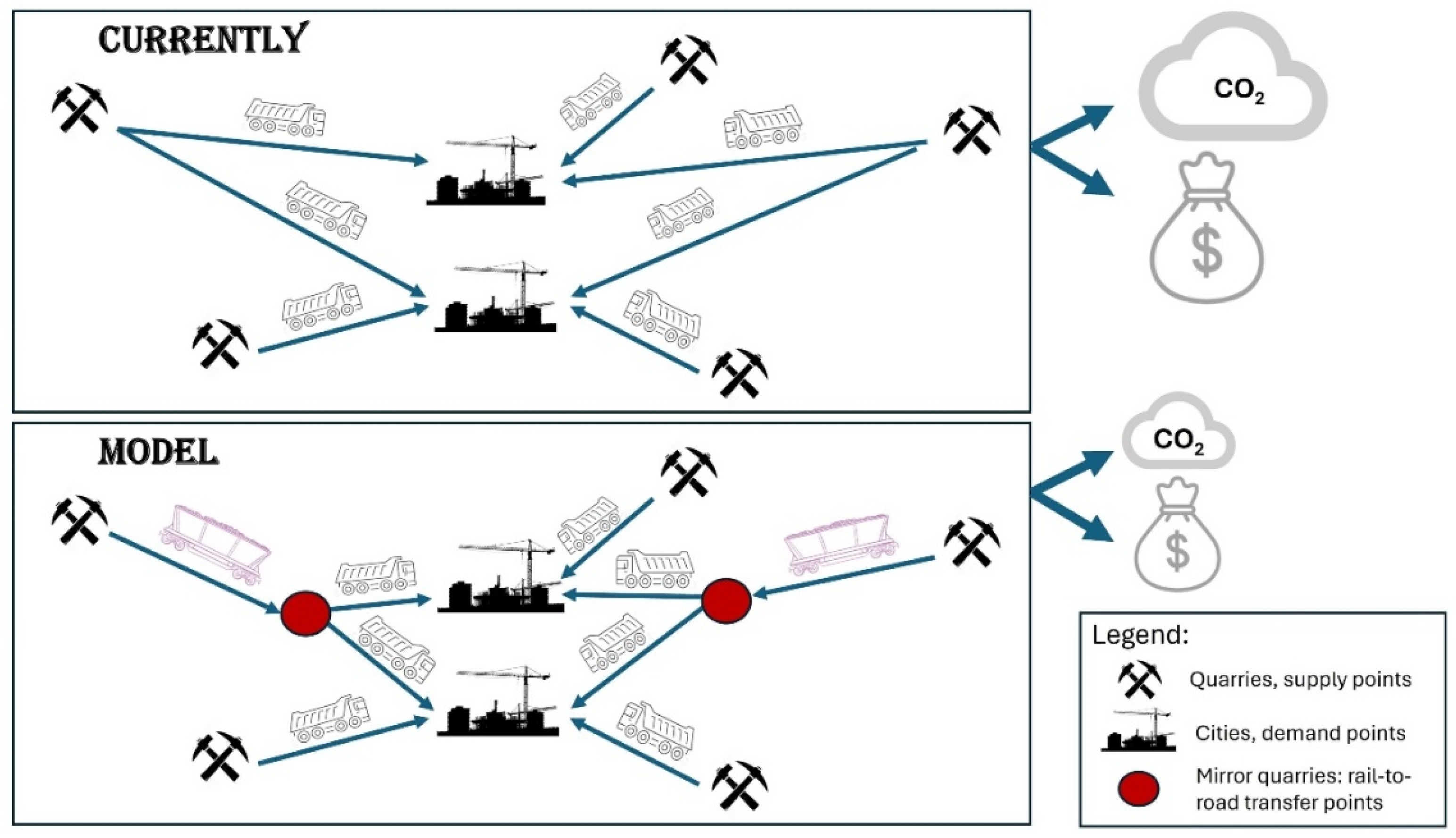
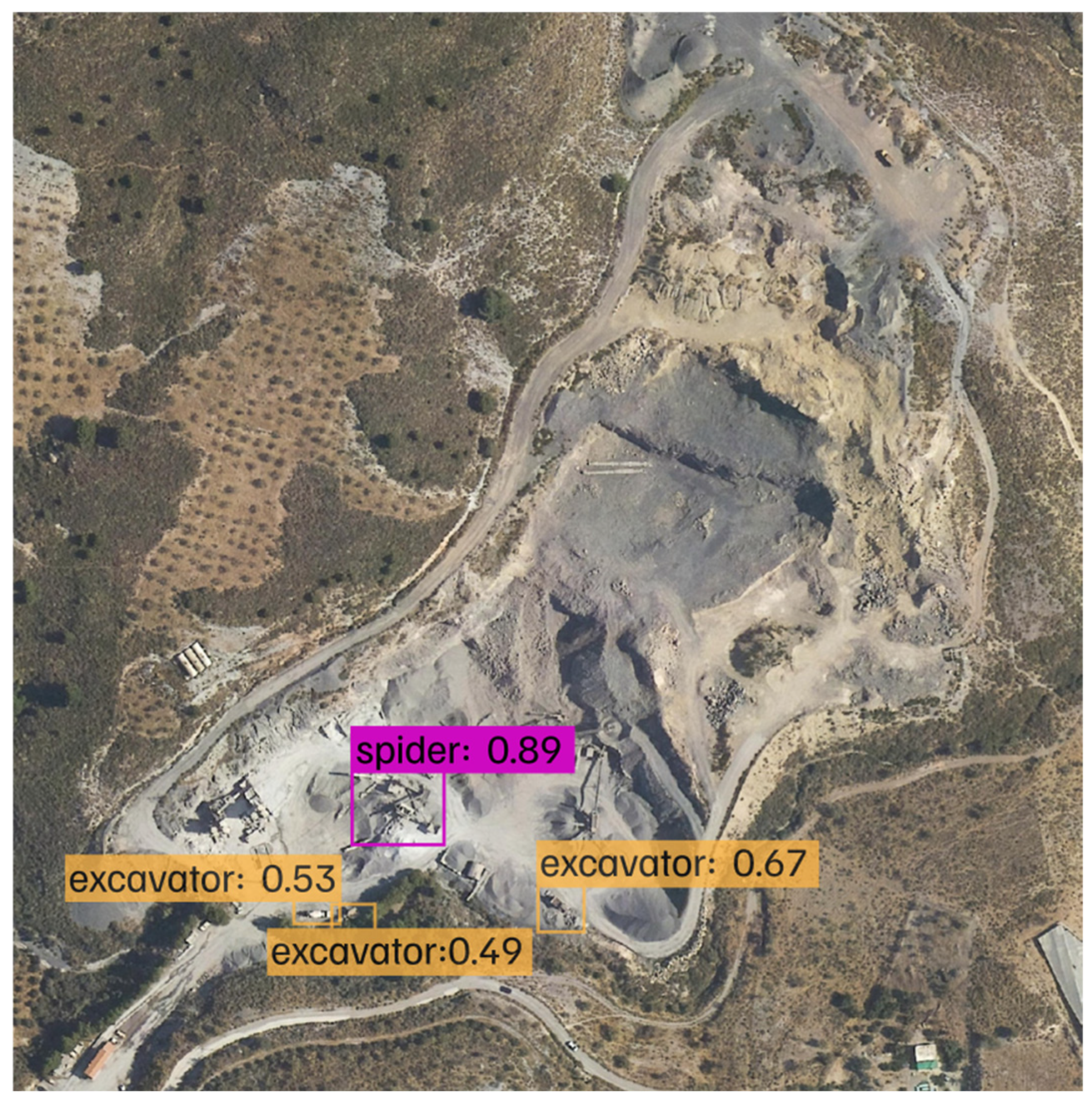

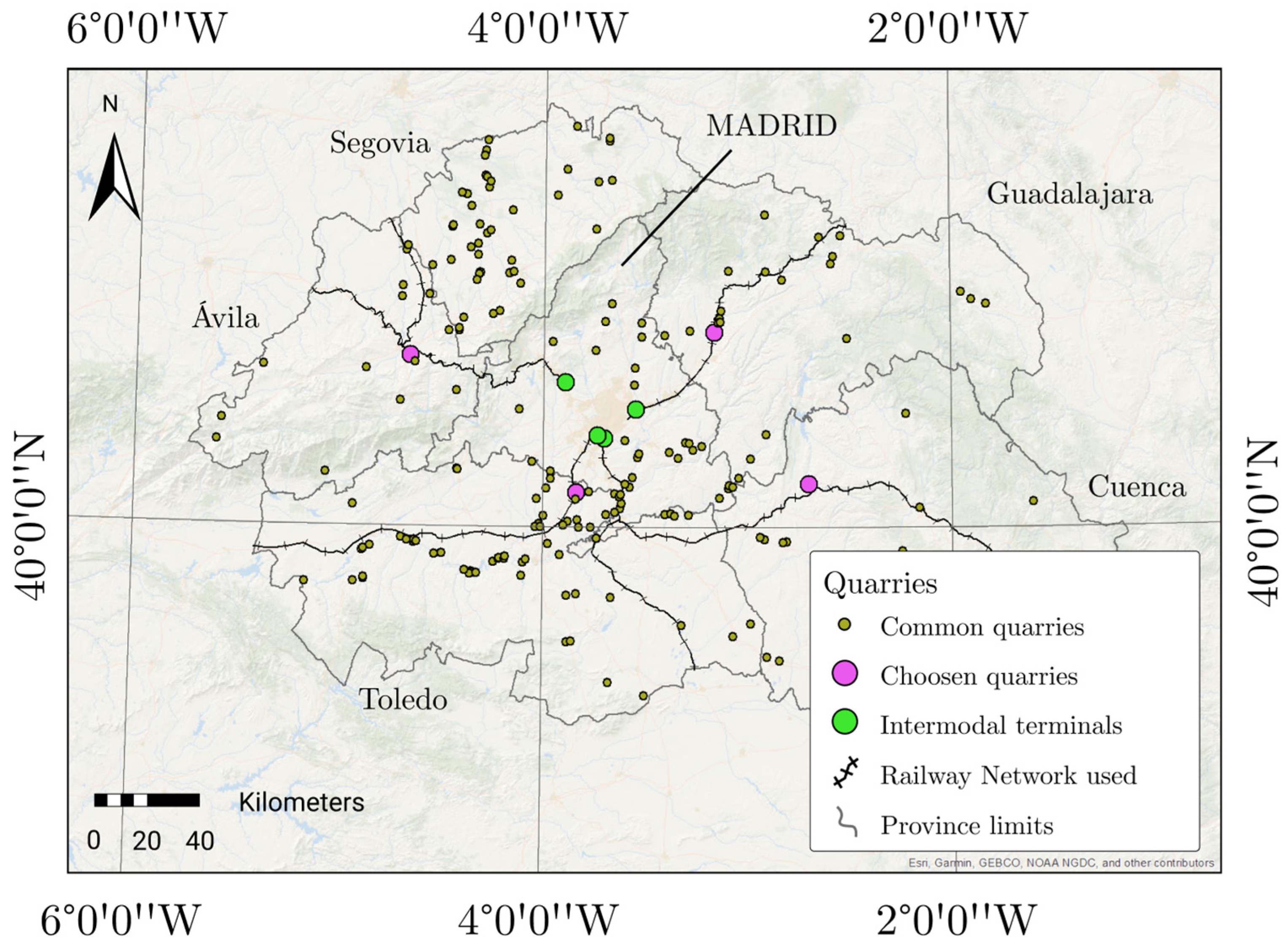
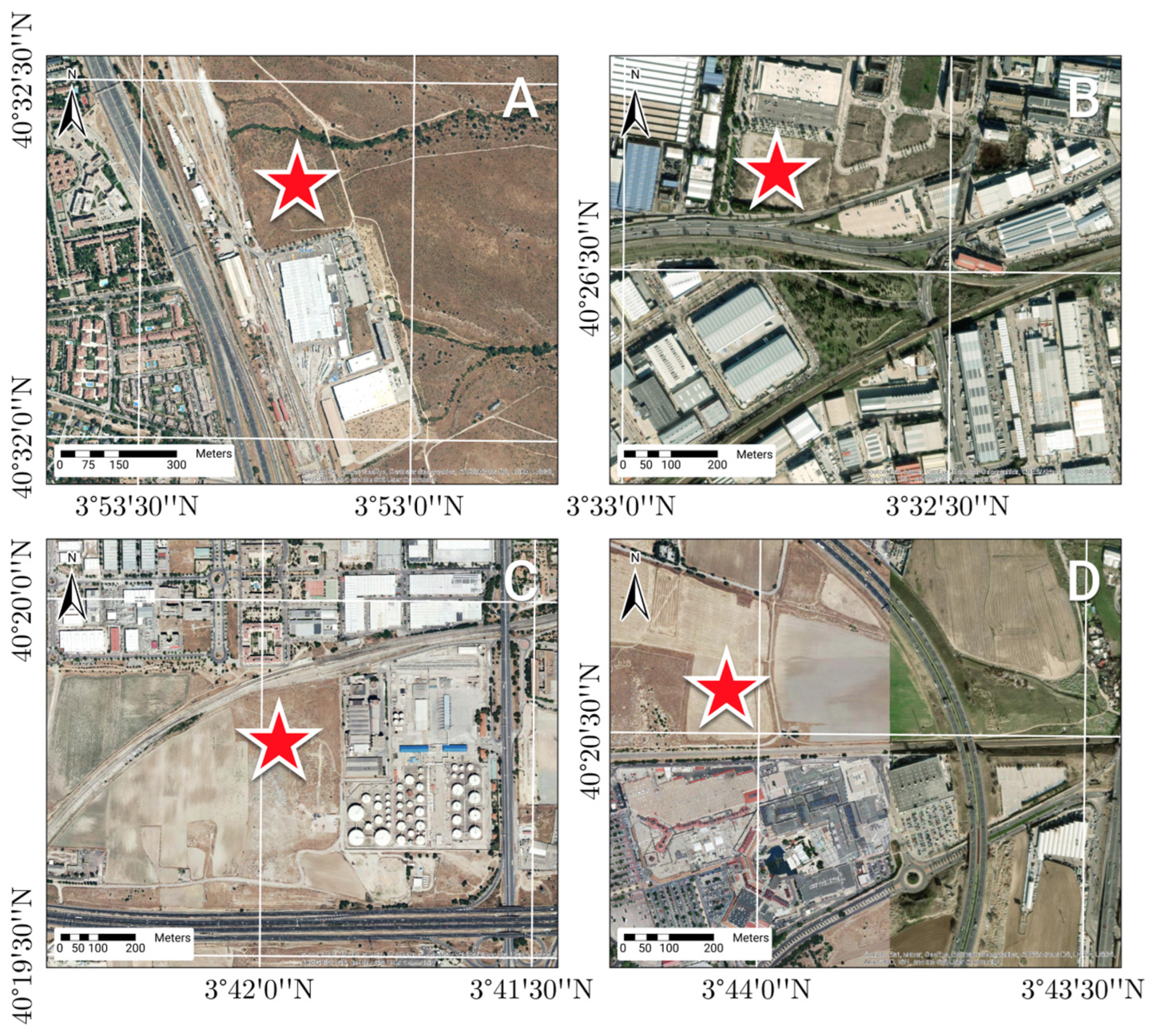
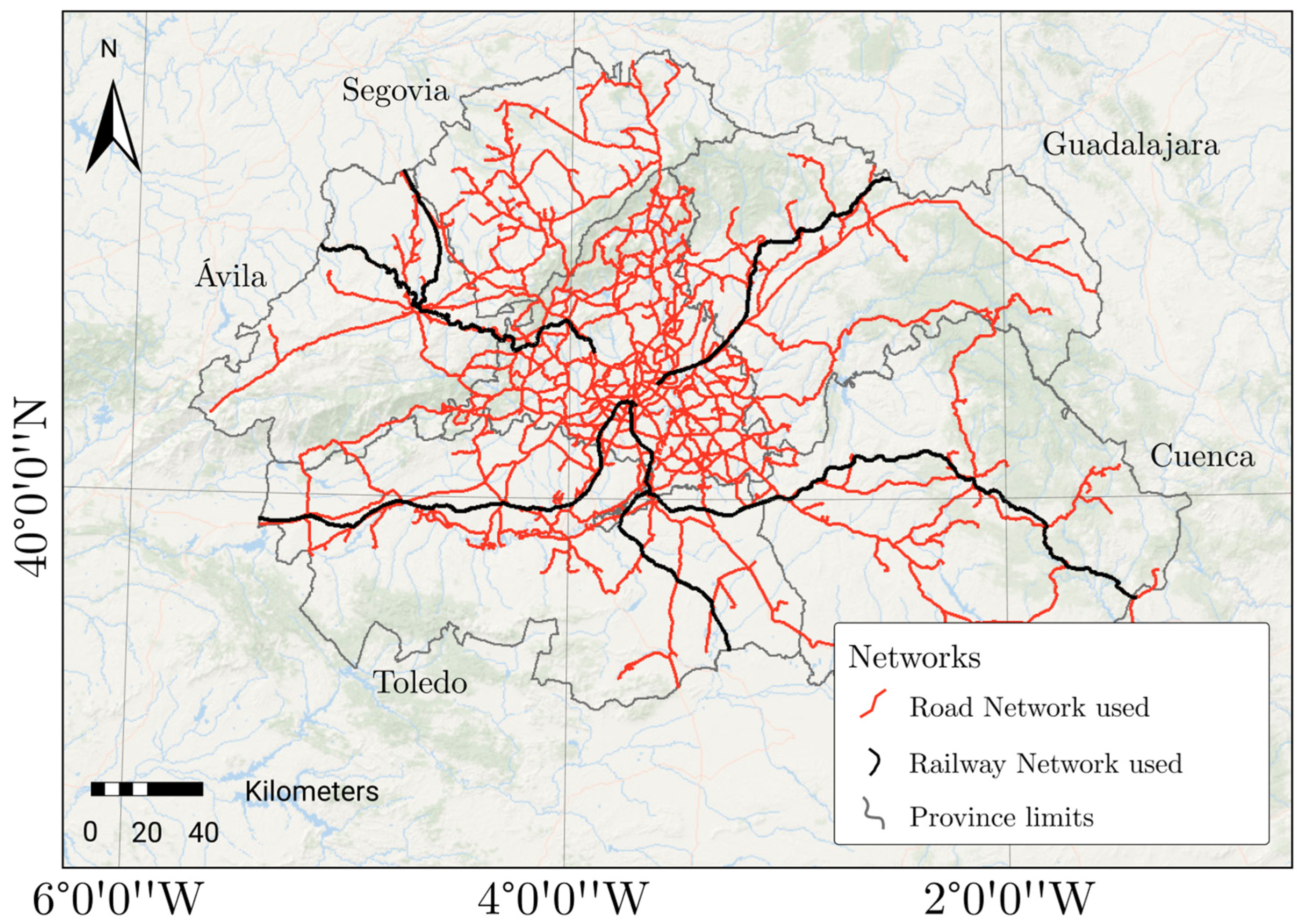
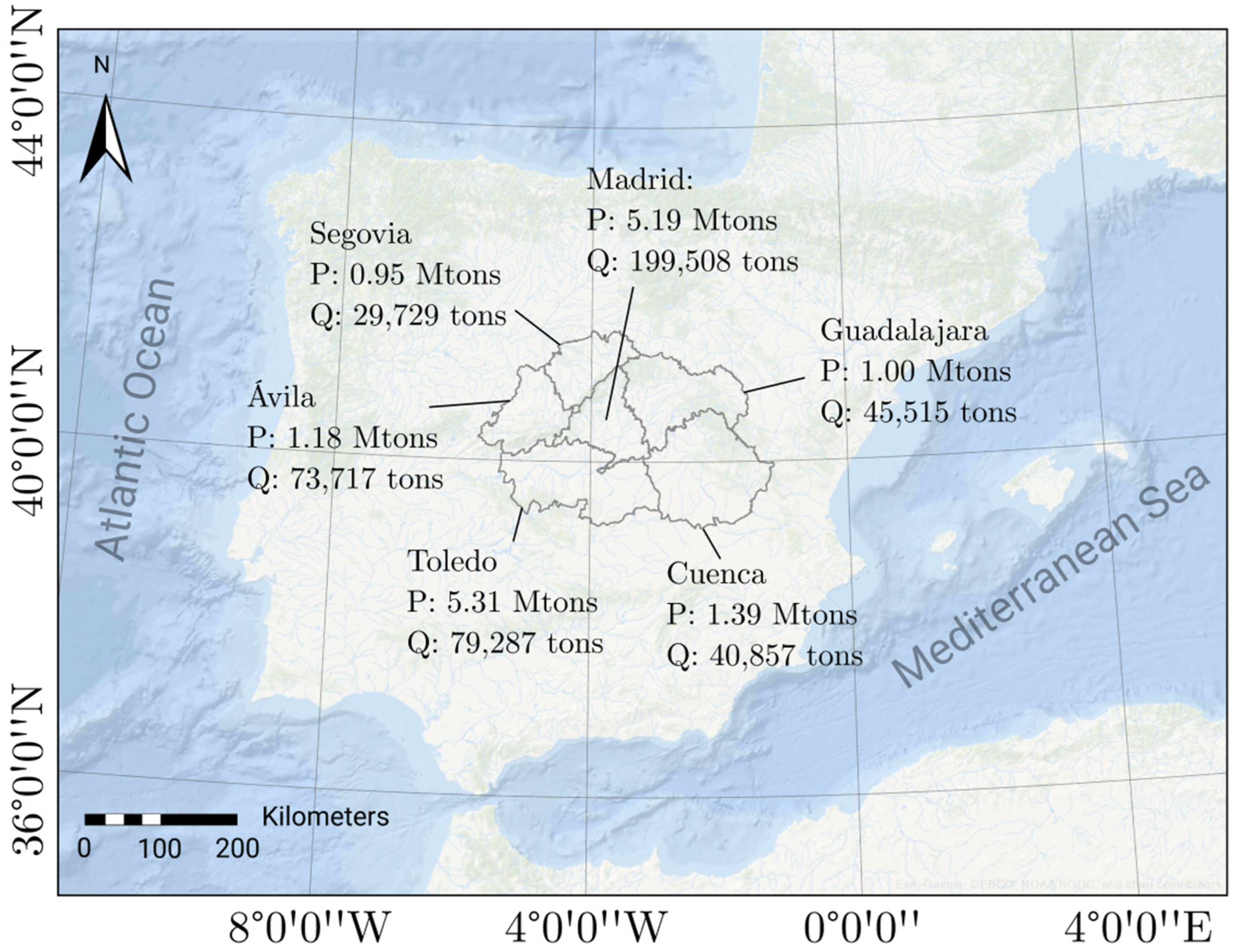
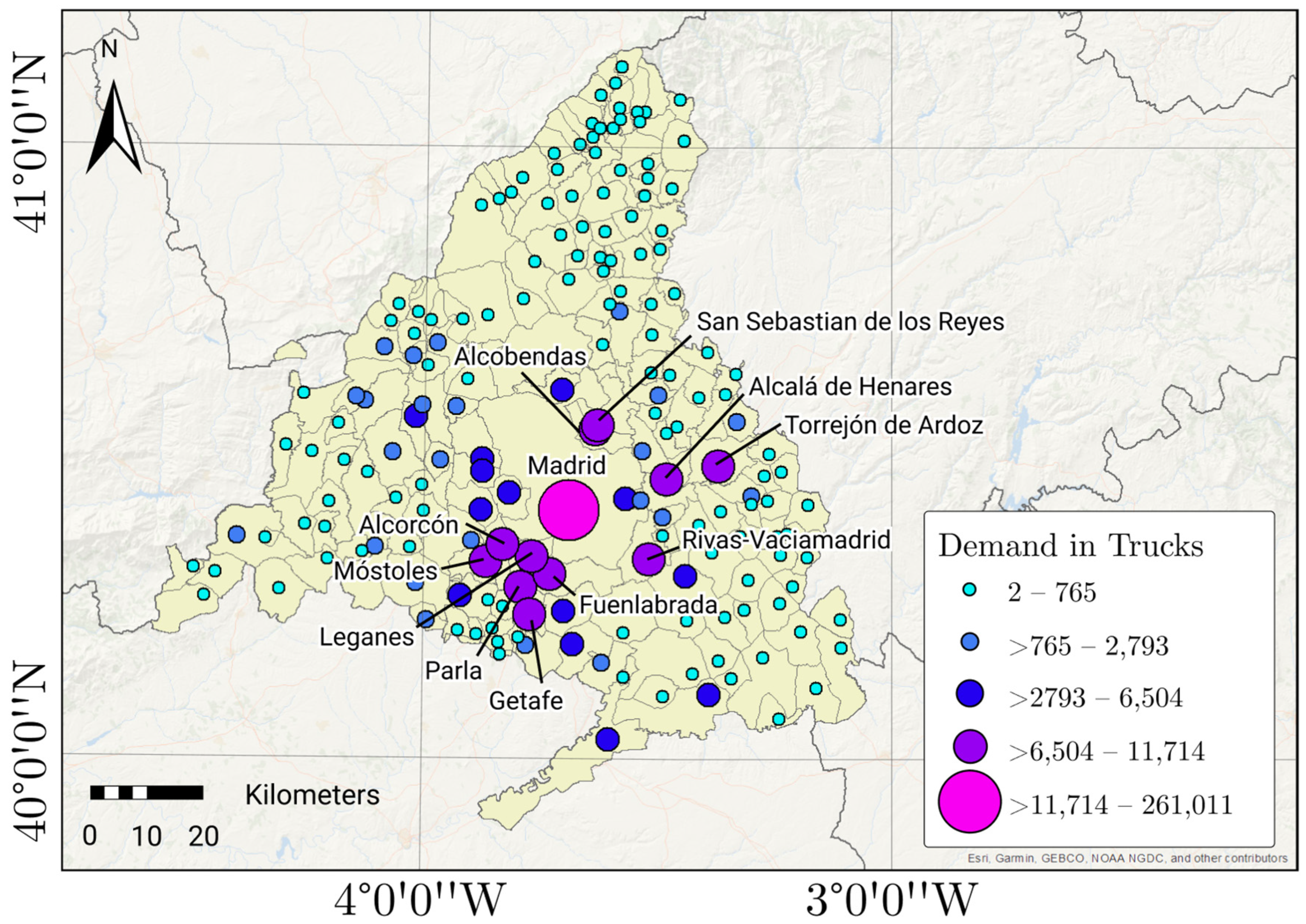
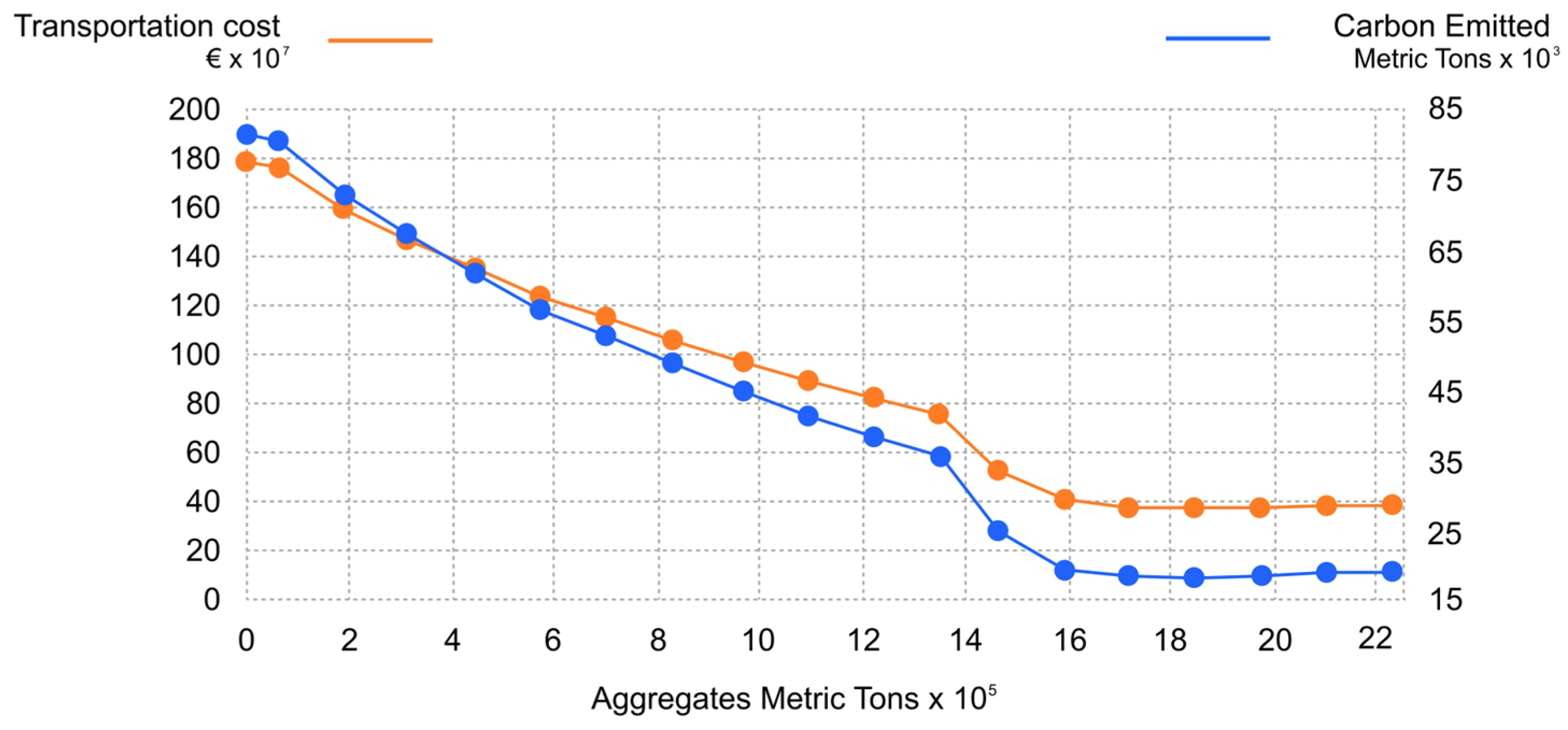
| Intermodal Terminals Production (Tons per Quarry) | Direct Truck Transportation (km) | Carbon Emitted by Trucks (Tons) | Carbon Emitted by Train (Tons) | Total Carbon Emissions (Tons) | Carbon Reduction (%) | Total Transport Cost (EUR) |
|---|---|---|---|---|---|---|
| - | 56,830,403 | 73,144 | - | 73,141 | - | 178,248,558 |
| 59,829 | 56,016,907 | 72,094 | 152 | 72,246 | 1.2 | 175,953,006 |
| 187,329 | 50,668,781 | 65,211 | 475 | 65,686 | 10.2 | 159,724,107 |
| 314,829 | 46,390,612 | 59,705 | 799 | 60,503 | 17.3 | 146,851,130 |
| 442,329 | 42,429,632 | 54,607 | 1122 | 55,729 | 23.8 | 134,973,016 |
| 569,829 | 38,854,287 | 50,005 | 1445 | 51,451 | 29.7 | 124,304,447 |
| 697,329 | 35,853,609 | 46,144 | 1769 | 47,912 | 34.5 | 115,438,320 |
| 824,829 | 32,801,693 | 42,216 | 2092 | 44,308 | 39.4 | 106,411,483 |
| 965,079 | 29,792,684 | 38,343 | 2448 | 40,791 | 44.2 | 97,573,777 |
| 1,092,579 | 27,244,313 | 35,063 | 2771 | 37,835 | 48.3 | 90,126,311 |
| 1,220,079 | 24,879,857 | 32,020 | 3095 | 35,115 | 52.0 | 83,255,693 |
| 1,347,579 | 22,732,339 | 29,257 | 3418 | 32,675 | 55.3 | 77,065,504 |
| 1,462,329 | 15,231,374 | 19,603 | 3709 | 23,312 | 68.1 | 54,029,677 |
| 1,589,829 | 11,095,915 | 14,280 | 4033 | 18,313 | 75.0 | 41,604,307 |
| 1,717,329 | 10,234,825 | 13,172 | 4356 | 17,528 | 76.0 | 39,449,000 |
| 1,844,829 | 9,971,623 | 12,833 | 4679 | 17,513 | 76.1 | 39,168,966 |
| 1,972,329 | 9,842,752 | 12,668 | 5003 | 17,670 | 75.8 | 39,310,261 |
| 2,099,829 | 9,842,752 | 12,668 | 5326 | 17,994 | 75.4 | 39,855,761 |
| 2,227,329 | 9,842,752 | 12,668 | 5650 | 18,317 | 75.0 | 40,401,260 |
Disclaimer/Publisher’s Note: The statements, opinions and data contained in all publications are solely those of the individual author(s) and contributor(s) and not of MDPI and/or the editor(s). MDPI and/or the editor(s) disclaim responsibility for any injury to people or property resulting from any ideas, methods, instructions or products referred to in the content. |
© 2024 by the authors. Licensee MDPI, Basel, Switzerland. This article is an open access article distributed under the terms and conditions of the Creative Commons Attribution (CC BY) license (https://creativecommons.org/licenses/by/4.0/).
Share and Cite
López-Acevedo, F.J.; Herrero, M.J.; Escavy Fernández, J.I.; González Bravo, J. Potential Reduction in Carbon Emissions in the Transport of Aggregates by Switching from Road-Only Transport to an Intermodal Rail/Road System. Sustainability 2024, 16, 9871. https://doi.org/10.3390/su16229871
López-Acevedo FJ, Herrero MJ, Escavy Fernández JI, González Bravo J. Potential Reduction in Carbon Emissions in the Transport of Aggregates by Switching from Road-Only Transport to an Intermodal Rail/Road System. Sustainability. 2024; 16(22):9871. https://doi.org/10.3390/su16229871
Chicago/Turabian StyleLópez-Acevedo, Francisco Javier, María Josefa Herrero, José Ignacio Escavy Fernández, and José González Bravo. 2024. "Potential Reduction in Carbon Emissions in the Transport of Aggregates by Switching from Road-Only Transport to an Intermodal Rail/Road System" Sustainability 16, no. 22: 9871. https://doi.org/10.3390/su16229871
APA StyleLópez-Acevedo, F. J., Herrero, M. J., Escavy Fernández, J. I., & González Bravo, J. (2024). Potential Reduction in Carbon Emissions in the Transport of Aggregates by Switching from Road-Only Transport to an Intermodal Rail/Road System. Sustainability, 16(22), 9871. https://doi.org/10.3390/su16229871







